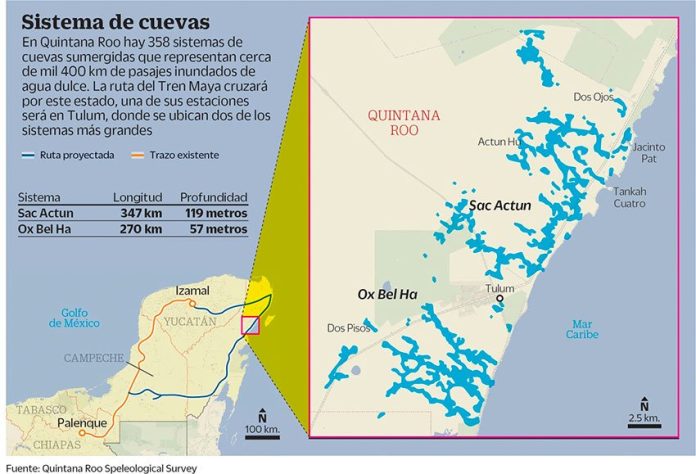Construction of the Maya Train on the Yucatán peninsula poses environmental risks to the region’s underground water networks and the long-term survival of the jaguar, experts have warned.
The 1,500-kilometer railroad, which will link cities in the three Yucatán peninsula states as well as Tabasco and Chiapas, has been rejected by indigenous communities but its construction was confirmed following a public consultation last month that found just under 90% support for the project.
The Sac Actún underwater cave system and the Dos Ojos system in Tulum, Quinana Roo – which together form the world’s largest cave – are among the subterranean bodies of water that could be adversely affected by construction of new railway tracks.
Experts also warn that the land above the aquifers may not be able to support the weight of the tracks and passing trains.
“These aquifers make up one the biggest fresh water storage areas on the planet; they’re of great importance to the ecosystem because a lot of tree roots are nourished from the water. In addition, they’re vital for the whole jungle and the present and future of the entire [Yucatán] peninsula,” said Francisco Remolina, a former director of the Yum Balam Natural Protected Area (ANP).
Arturo Bayona, the scientist who was in charge of carrying out the environmental studies for the ambitious mapping venture known as the Great Mayan Aquifer (GAM) project, said there is a risk of fissures opening up if the railroad is built where there is only a thin layer of karst – an area of land made up of limestone.
“Soil surveys are fundamental because you need to ensure that the rock layer is strong enough to, firstly, support the weight of the train and later, the vibration it causes when it passes,” he said.
Emiliano Monroy, a hydrogeologist at Northwestern University in Illinois, United States, is also concerned about the potential impact of train vibrations.
“Some cave systems are very unstable, we don’t know whether there is a two-tonne rock beneath the track or one that could easily be displaced. You also need to consider that vibrations will be generated for years and that could accelerate the natural process of collapses,” he said.
GAM project director Guillermo de Anda said it is essential to carry out a comprehensive assessment of the land on which the Maya Train is slated to run before any construction work begins.
“First recommendation: if something is going to be built, you have to be sure that the ground is appropriate and take into account that you shouldn’t drill down too deep. The ideal route [for the train] would be that which least endangers the karst areas and the subterranean areas in accordance with a formal study that determines the porosity, structure and strength [of the land] . . .” he said.
The experts say that land where there are already tracks that the Maya Train intends to use must also be evaluated.
“When those tracks were built we had no idea about the peninsula’s subsurface structures, its geological structures. How do we know if that leg [of the route] crosses a 200-meter-wide cavity or several cenotes [water-filled sinkholes]?” de Anda asked.
Monroy said that carrying out the studies required would take “at least a year,” a timeframe that would stymie President López Obrador’s plan for construction to start this month.
Bayona said that construction of the stations for the new railroad is also a cause for concern, pointing specifically to the pressure thousands of passengers will place on sewage systems.
“Where is the wastewater, generated by thousands of [train] users, going to go?” he asked.
Remolina, who is now a member of a wild cats conservation group, said the planned route of the railroad would also affect areas where many of Mexico’s dwindling population of jaguars live.
Building the Maya Train rail line is akin to putting up a barrier that will limit jaguars’ home range within which they hunt, reproduce and raise their young, he said.
“If we put up a ‘wall’ that restricts the jaguar from passing from one side to the other, we’re going to bring about [a situation] in which these animals can’t . . . reproduce with individuals that are genetically a little bit more removed from them, we’ll deny them the chance of having greater genetic variability with which to ‘nourish themselves,’” Remolina said.
“Barging in on the jaguar’s home range would cause, in the future, consanguinity. Little by little, we could edge towards [a situation] in which they have less chance of survival,” he added.
De Anda said that the experts’ views didn’t amount to a complete rejection of the 120 to 150-billion-peso (US $5.9-billion to $7.4-billion) project, which is designed to boost the economy in the southeast of Mexico, but rather as a reminder that utmost environmental care must be taken.
“If it’s a social benefit program, we can’t oppose it being done. But we can . . . demand that it be done in an orderly way and, above all, that it be supported by science . . . Obviously, any project in an area as sensitive as Tulum makes certain places vulnerable. That’s why we have to be extremely careful,” he said.
Source: El Universal (sp)
